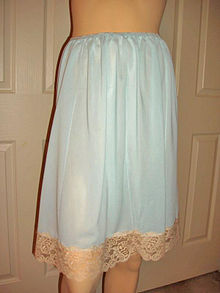Petticoat
The petticoat (obsolete petticoat ) is an item of laundry that is similar in shape to a pinafore or skirt . In order to distinguish the skirt shape from the petticoat, the term “half petticoat” or “half skirt” is used.
The petticoat is used to maintain body heat - although the materials and the number of petticoats worn used to adapt to the seasons - and the fit of the garments and also prevents the contours of the rest of the underwear from showing under the outer garments. The overskirt glides more easily around the wearer's legs thanks to the smooth surface of the underskirt ( linen , silk , polyester , polyamide or Dederon). Many skirts and dresses nowadays have a smooth inner lining , so that the need for a separate underskirt is often no longer necessary.
history
In ancient times one usually wore nothing under the tunic . Underwear came on later. From the 16th to the first half of the 18th century, the petticoat was often called cotillon . At that time aristocratic and middle-class women usually wore several petticoats under the dress; the petticoat was a symbol of class. In the 17th century up to eight petticoats were worn at the same time in summer and up to twelve in winter. The top one, often with a train , was called la modeste (French for "the modest"), the middle one la friponne ("the mischievous"), the bottom la secrète ("the secret ones "). In the Rococo , the petticoat, which became visible when the hoop skirt was lifted , was made of silk and embroidered around the hem in the case of fine ladies.
Around 1820 the petticoat began to be sewn onto the bodice and so an undergarment was obtained. At this time the crinoline also appeared. The petticoat was gathered over the buttocks under the turn or the cul de Paris . In 1897 "petticoats" were worn. At this time, the petticoat with train and ruffles came back into fashion. In the Wilhelminian era and in Art Nouveau petticoats were often lavishly decorated with ribbons or embroidery . In addition to white linen, petticoats, especially for traditional costumes , were mostly dark tones with woven or printed stripes or flower patterns. For the winter there were petticoats padded with sheep's wool . A petticoat or, depending on the climate and season, several petticoats are also part of the habit of many religious women .
Individual evidence
- ↑ http://www.duden.de/rechtschreibung/Unterrock
- ↑ http://www.duden.de/rechtschreibung/Halbrock
- ↑ http://www.augsburger-allgemeine.de/noerdlingen/UnentbehrlicheTextilie-id22924256.html From the petticoat: Indispensable textile

